From High Heel to Thigh High: Power Shoes in Pop Culture
-
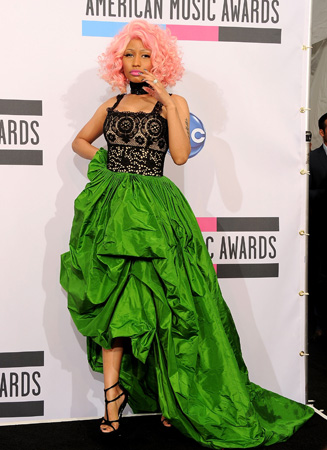 Jason Merritt/Getty Images.
Jason Merritt/Getty Images.Nicki Minaj in Heelless Shoes (2012)
The past four years have seen a rise—literally—in outrageous shoes. Prices and heel heights have skyrocketed. No-heel platform booties—versions have been designed by Alexander McQueen and Giuseppi Zanoitti and worn by Lady Gaga, Nicki Minaj, and Victoria Beckham—are just the latest extreme “it” shoe to emerge at a time notable for its stark relationship between functionality and favor (the less functional the shoe, the more celebrated it is). The success of wildly vertiginous and expensive shoes in the aftermath of the recession (in November 2009, the New York Times reported that shoe sales had climbed 7.8 percent year-over-year) opened up a conversation about whether shoes that require consumers to alter their strides and empty their wallets are debilitating or empowering. Are Zanottis, Louboutins, and Manolos (and their mid- and mass-market counterparts) our era’s version of Chinese foot binding, or are they power? A look back at shoes in pop-culture history reveals that the answer is complex.
-
The Postman Always Rings Twice (1946)/Warner Bros.
Cora Smith in Salvatore Ferragamos (1946)
Before World War II, gender roles were clear: Men went to work, wore the pants, and fought for their country. But then a shortage of men on American soil required women to take up typically “masculine” jobs. Enter the femme fatale: In the war’s aftermath, a vicious kind of woman appeared on screen, establishing the high heel as an instrument of female power, and a nefarious one at that. In The Postman Always Rings Twice, Lana Turner starred as Cora Smith, who, in white, open-toed Salvatore Ferragamo pumps, seduces a drifter named Frank to help murder her husband. Turner’s character was the embodiment of post-war anxieties about women emasculating their men.
-
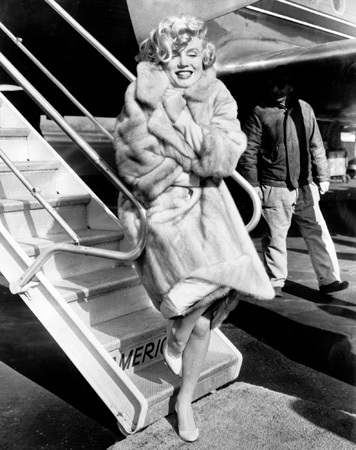 STR/AFP/Getty Images.
STR/AFP/Getty Images.Marilyn Monroe in Stilettos (1950s)
Eventually, the war’s shadow passed, and the 1950s ushered in a new era outwardly characterized by white picket fences, the American dream, and Marilyn Monroe, who popularized a new style of shoe with a thin, needle-like heel. Marilyn wasn’t shy in confessing her love of this footwear (“I don’t know who invented the high heel, but women owe him a lot,” she once purred). Unlike high heels in the 1940s, which had a thicker surface area, the stiletto required women to balance carefully and alter their gaits. No longer expected to pinch pennies or work in factories, women were now free to mimic the ultra feminine pin-up girls. Wearing stilettos was a concise way of communicating privilege—the woman who wore them could afford to stay off her feet.
-
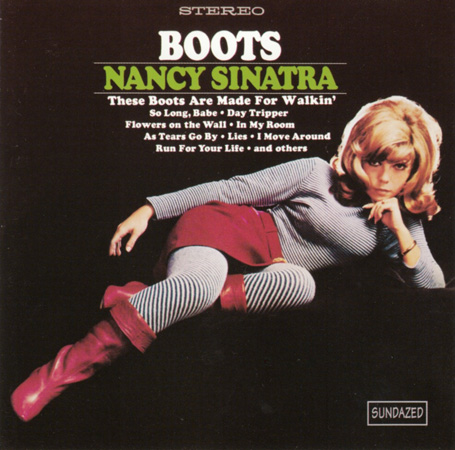 Album Cover/Reprise.
Album Cover/Reprise.Nancy Sinatra in Sensible Boots (1966)
As the women’s movement stirred, critics of the high heel questioned whether a shoe that compromises one’s stride can be considered anything but oppressive. Many libbers wore comfortable shoes like Birkenstocks, but even mainstream fashion responded to changing sexual mores. When Nancy Sinatra released her now-classic single, she promoted it in medium-heeled boots inspired by the mods on London’s Carnaby Street. They looked cutting-edge and allowed for greater mobility: A perfect match for a song about a woman who feels strong enough to kick a cheating man to the curb.
-
Barbarella (1968)/ Paramount Pictures.
Barbarella in Cuissardes (1968)
Speaking of boots and power, the campy space saga Barbarella starred Jane Fonda in the title role, her revealing outfits instrumental in her cause to win over the universe via the forces of free love. Wearing thigh-high boots called cuissardes, Barbarella was the perfect heroine for the sexual revolution. Like the femme fatale, she used her body as an asset, but unlike her 1940s predecessors, she wasn’t punished for it. The success of the film proved that late-’60s audiences were ready for a female character who embraced her sexuality. If Nancy’s boots were made for walking, these boots were intended for something a little less upright.
-
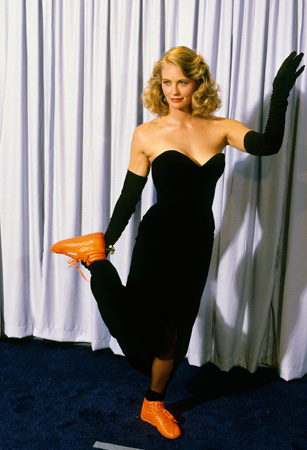 ABC Photo Archives/ABC via Getty Images.
ABC Photo Archives/ABC via Getty Images.Cybill Shepherd in Reebok Freestyles at the Emmys (1985)
With the aerobics craze, women in the ’80s found themselves at the forefront of an athletic movement, and sneaker companies responded in kind. In 1978, New Balance modified its popular 320 running shoe and released the W320, adapted for female bodies. Then, in 1982, Reebok debuted the Freestyle: The first athletic shoe designed specifically for women. With the slogan “Life is not a spectator sport,” Reebok’s 1986 campaign featured the Freestyle on celebrities like Cindy Crawford and Paula Abdul—inspiring women to go to the aerobics studio, strengthen their bodies, and buy more shoes.
-
Working Girl (1988)/Twentieth Century Fox.
Tess Commuting in Sneakers in Working Girl (1988)
As more women entered the workforce in the late-’70s and early-’80s, they were required to straddle a difficult line: How to remain feminine—so as not to be accused of trying to “be” men—while also commanding respect? The answer: Drag an extra pair of shoes to the office. Melanie Griffith as Tess McGill in Working Girl embodies this particular moment, dueling against a competitive female boss who has lost her sense of compassion. For her early-morning haul into Manhattan from Staten Island, Tess wears white sneakers, and then changes into office-appropriate heels once she gets to her desk. By this time, only women who could afford to take cabs wore their high heels door-to-door, earning these status pumps the nickname “limousine shoes.”
-
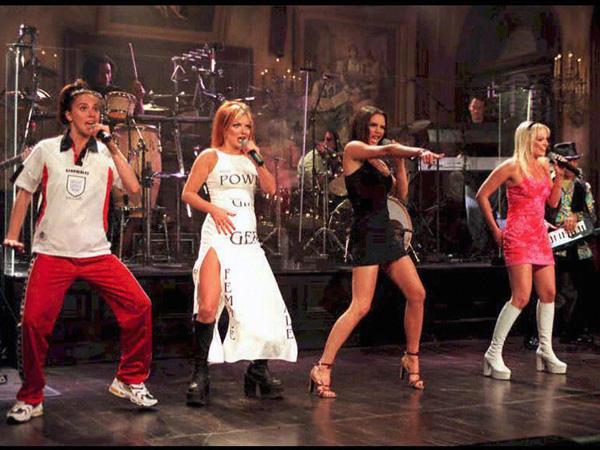 Mary Ellen Matthews/AFP/Getty Images.
Mary Ellen Matthews/AFP/Getty Images.The Spice Girls in Platform Boots (1996)
Can a woman be powerful in a thigh-skimming minidress and vinyl platform boots? The Spice Girls thought so. After the door closed on grunge, androgyny gave way to exaggerated femininity, summed up in the catchphrase “Girl Power.” The Spice Girls found fame with their bubblegum hits and obvious sexuality, wearing clothes that highlighted their breasts, legs, and hips. The message—embraced by their fans, who were largely young and female, and criticized by scolds for setting a bad example—was that femininity, in and of itself, could be a strength. The boots made them look larger-than-life on stage: A trick they must have learned from ’70s glam rockers like Marc Bolan and David Bowie.
-
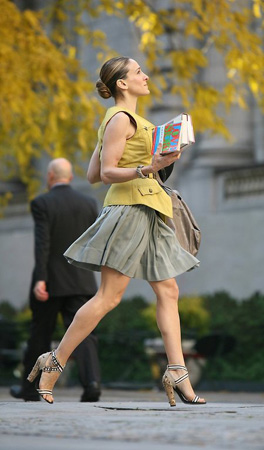 HBO.
HBO.Carrie Bradshaw in General (1998-2010)
Carrie loved her friends even more than she loved her collection of designer shoes—which is saying a lot. She was superficial in plenty of ways, but Sex and the City resonated in part because Carrie exhibited a new kind of female freedom: fiscal lib. Her Manolos—and later, her Jimmy Choos and Christian Louboutins—spoke to the power of her financial independence. Carrie and her friends wanted shoes so they bought them. Shoes had come to symbolize sexuality, economic freedom and status. No wonder they’re so popular.
-
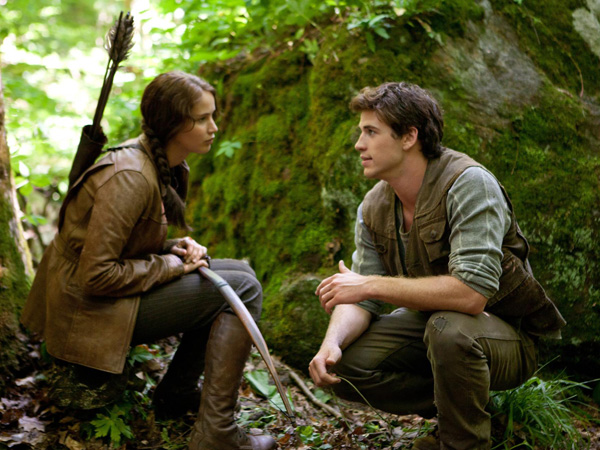 Hunger Games/Lionsgate.
Hunger Games/Lionsgate.Katniss Everdeen in Lace-Up Boots (2012)
Like the formidable action heroines who came before her (think Emma Peel in The Avengers, Lara Croft in Tomb Raider, and of course, Wonder Woman), The Hunger Games’ Katniss Everdeen triumphs over the odds with a mix of physical and emotional strength. When audiences first meet her, she’s wearing practical, knee-high lace-up boots, perfect for a huntress who traipses through the woods. Most female action heroes wear sensible, if tough looking, shoes, but there are exceptions. In The Avengers, Scarlett Johansson’s Black Widow takes down a group of men while barefoot, then pauses to pick up her very high black patent leather slingbacks. It’s a wink to the audience to show that Black Widow is outrageously strong and feminine—a potent mix.